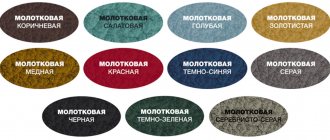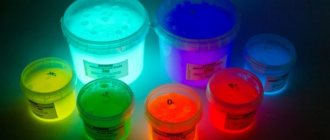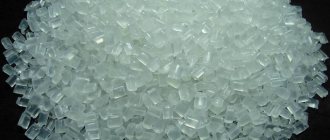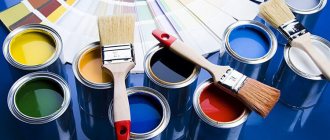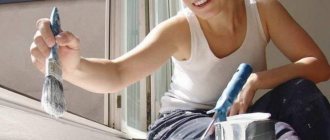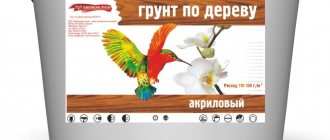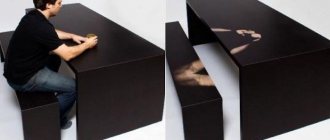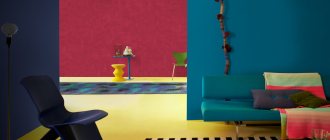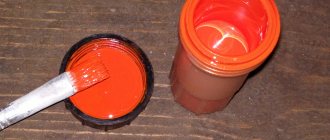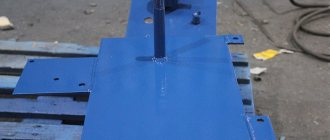Experiments with building materials continue. Thanks to this, new materials are emerging that have better characteristics and are much superior to their analogues. One of these was rubber paint. It received this name because its properties are similar to this material.
A detailed review of rubber paint will help you decide whether to use it for painting. What is rubber paint made of? What are its advantages and disadvantages? What application features can be identified?
Main types
Depending on the task you are faced with, you can choose your own type of paint. This can be a product that is applied with a brush or roller, or a product that is sprayed from a can. All this determines the scope of application, expands capabilities, and allows you to quickly and accurately cover large areas.
Otherwise, manufacturers divide the product depending on the type of coating to which it is applied. That is, there are paints for wood, concrete, brick, as well as varieties for plastic, plaster and other surfaces. Each manufacturer focuses on its own line.
For example, it has established itself as one of the best among those focused on the production of paint for under-roofing systems. This creates a highly airtight coating that does not allow moisture to enter the space under the roof.
brings to market a product that is ideal for indoor work. This is due to the fact that only natural oils, including tree sap, are used in the manufacturing process. This eliminates odor and improves properties, but attracts insects and bacteria, which requires operation only in the absence of dampness, i.e. indoors.
Rubber paint "Tikurilla" has long been famous for its name in the domestic market. It is resistant to damage and scratches, ideal for wood. Rubber paint for exterior use is suitable for outdoor use.
The most economical way to apply paint is with a brush.
Interior paint can be used to treat interior walls, as well as floors, ceilings, and other types of wood surfaces. There are many varieties, but they all depend individually on the manufacturer. Therefore, before purchasing, read the ingredients, consult with professionals, and check customer reviews.
Materials coated with rubber paint
Liquid rubber fits perfectly on most types of substrates - concrete, brick, metal, tiles, natural and artificial stone, wood, MDF, OSB, drywall, plaster, putty, asphalt, polypropylene, polyurethane. You can apply paints and varnishes to other varnishes and paints without removing the previous layer. This product can be applied even to glued vinyl and non-woven wallpaper without loss of properties.
The material is also suitable for wooden surfaces due to its ability to inhibit rotting - it contains fungicidal additives. The paint will not crack at the joints of the floor slats, which move due to temperature changes. Products made of any metals - ferrous and non-ferrous, and alloys - can be processed with liquid rubber.
Thanks to its properties, the paint can be used in places with special conditions:
- at high humidity,
- closed, poorly ventilated rooms, without windows,
- slippery surfaces,
- frequently cracked areas
- places with temperature changes.
Compound
In order for the paint to be identical after drying, it is very important that its composition is correctly selected. The components must provide elasticity. This is what latex is responsible for in paint. From product to product, up to 15 percent latex additive may be included.
Unlike other manufactured products, latex paint necessarily includes antifreeze. This ensures reliable storage and transportation, at the same time, retains its service properties after application outdoors, under the influence of frost. There is little water in the composition, usually this figure does not exceed 7 percent.
The composition may include an additive such as a coalescent. The narrow specificity of the raw material, aimed at forming a film, allows you to create a reliable waterproof coating, which then allows you to form a reliable under-roof carpet.
When the product is applied to wood, it is important not only to create a film, but also to provide protection from fungus, moisture and bacteria. That is why a preservative must be included in the composition. It penetrates deeply into the structure of the material, providing protection against the listed factors for decades.
Rubber paint is indispensable for use in swimming pools
Again, it all depends on the quality of the product, including its cost and manufacturer. It is imperative that the product contains pigment, dye and other inclusions that ensure the product is ready for use, as well as its richness of color and texture.
More expensive rubber paint, over 2000 rubles per can
Rezolux Universal
This product is distinguished by its long-lasting durability; it stays on surfaces for as long as possible, maintaining its original appearance. It is thanks to this feature that the paint is perfect for swimming pools, fountains and other applications associated with constant contact with water. In this case, the product can be applied to any substrate and material. The product tolerates any negative external factors and is not afraid of bad weather conditions and mechanical damage. The composition of the product is safe, it does not contain harmful components, and during operation the paint does not emit toxic substances, which makes it possible to paint objects on playgrounds and playrooms with it.
If stains and dirt appear, hygienic cleaning will not be difficult, since all dirt can be washed off with any detergent without damaging the painted layers.
However, in order to get a lasting and high-quality result, you must follow all the nuances of operation. For example, the manufacturer advises to wait until it dries completely after painting; this will take 3-4 weeks.
rubber paint Rezolux Universal
Advantages:
- can be applied to any surface, including wood;
- not afraid of moisture and mold;
- does not fade;
- scratches, chips and other defects do not appear;
- easy to clean.
Flaws:
- it is necessary to wait for complete drying for 3-4 weeks;
- high price.
The average cost is 5,000 Russian rubles.
GoodHim Elastic
The paint is not afraid of dampness and moisture, and it is also not afraid of prolonged heavy rains, which means it will be an excellent choice for painting the external walls of a house. At the same time, high strength and elasticity are successfully combined with air circulation in the walls. You can also paint interior walls with the product; this paint has proven itself especially well in use in conditions of high humidity.
The paint can be applied to minor scratches and chips on surfaces; the resulting layer lies smoothly and hides defects. Repeated application of the layer results in a dense, stable coating. It is worth noting that the product is afraid of intense mechanical influences and loads, so it is not suitable for use in various industries.
For household use, such a product is perfect due to its durability, excellent results, the ability to hide imperfections and defects on the substrate, and also due to its ease of cleaning. It will not be difficult to wash off dirt from such paint, and even under the influence of intense detergents the coating will not be damaged.
rubber paint GoodHim Elastic
Advantages:
- elastic resistant coating;
- not afraid of dampness and moisture;
- water resistance;
- allows air to pass through;
- does not crack;
- masks defects.
Flaws:
- cannot withstand intense mechanical loads.
The average cost is 2,300 Russian rubles.
NovBytKhim Chief Technologist
This option is suitable for those users who want to transform the facade of the house, its external walls or roof. The product is also suitable for interior decoration. The paint adheres well, it is flexible, and it is easy to work with even for inexperienced users. After application, the paint does not deform due to shrinkage or temperature changes. Don't worry if the surface has small defects; they can be easily covered with this product.
In addition, according to reviews, this product is perfect for painting a pool, fountain or other artificial reservoir. A high level of water resistance will ensure long-term operation, but do not forget about proper preparation of the base before processing.
The disadvantages of the product include its low resistance to physical impact; defects quickly appear on the surface due to mechanical damage. This is why we do not recommend applying the product to the floor. Also, the product has a relatively high price, and its composition is quite standard, it does not differ from cheaper analogues.
rubber paint NovBytKhim Chief technologist
Advantages:
- can be applied under any, even the most extreme, weather conditions and at any temperature;
- does not require a perfectly flat base;
- hides minor defects;
- ease of application;
- not afraid of prolonged contact with water.
Flaws:
- not recommended for use on the floor;
- high price.
The average cost is 4,000 Russian rubles.
Properties and characteristics
Now we know what components the paint consists of, we can talk about the parameters that the buyer will receive with the purchase:
- High resistance to ultraviolet exposure to sunlight, bad weather, moisture levels, and time. The latter means that the paint does not fade for a long time, maintaining its original shade.
- Vapor permeability and waterproofing. This is important when it comes to decorating your home. Here it is important to maintain the microclimate inside the room and protect it from moisture from the outside. Therefore, the applied rubberized base is best suited for solving these problems. The latter allows you to apply paint not only under the surface of the roof, but also to use it as a waterproofing for the concrete base of the pool, thereby sealing and transforming the overall design. In swimming pools, we encounter another property, such as a non-slip surface. This is important because it increases operational safety, because the bottom will not slip. Safety is also high because during operation there are no toxins or odors that cause an allergic reaction.
- Fast drying speed. Thanks to this, you can paint directly indoors, based on the fact that good rubber floor paint can dry in just a couple of hours. There is no smell.
- Affordable price segment. Despite these professional characteristics, the product is available for purchase by individuals or construction professionals for large-scale work.
What surfaces is rubber paint suitable for?
Rubber paint specializes in waterproofing and compensation of base movements. Such properties require high adhesion and elasticity. Therefore, the range of use of the material is incredibly wide.
Rubber paint can be applied to:
- Concrete.
- Brick.
- Natural or artificial stone.
- Galvanized or black iron.
- Wood.
- All types of plaster.
- Gypsum.
- Plastic, etc.
Such a variety of materials capable of interacting with rubber paint makes it a universal finishing product with unique uses.
Application
The scope of application of such products is as wide as possible, so it covers private areas and areas of capital development:
Rubber paint can be used to paint roofs
- Facades of capital and private houses. The surface is maximally resistant to precipitation. It is covered with a protective film, onto which moisture gets in and does not penetrate the façade, washing away the dirt along with the runoff. It always remains rich and pleasing to the outside eye. There is no need to tint, it will last for about 5-7 years.
- Swimming pools. Here, such properties as aesthetics and the formation of a waterproofing layer are taken into account. For example, most people choose a blue tint for swimming pools. The surface is non-slip, so even children can safely enter the pool. In this way, you can prepare the concrete, then apply paint to the surface and add water after drying. The main thing to remember is that the finishing coating can be applied only after the concrete has completely dried, which is 28 days.
- Treadmills. They are made multi-colored using rubberized paint. Analogues cannot be used here, since the manufacturer cannot risk the quality of its products, because the track itself must be non-slip and have high resistance to friction by shoes.
- Interior items. Products made of wood and leather stand out here. Rubber paint for wood not only gives a natural shade of color, makes it rich, but also protects it from destruction by moisture. Peeling is excluded, as is exposure to moisture on objects. In addition, working with the application does not require any special skills, so the work can be done independently. This will save on hiring workers.
Features, advantages, disadvantages
The strength of the material allows the paint to be used on roofs, sports fields, bicycle tracks, and floor coverings. The paint lasts up to 8 years without loss of quality and aesthetic properties. A unique opportunity to repair a separate area by applying a new layer only to the defective area - this is only possible when using latex and acrylic paints and varnishes.
Rubber paint has excellent moisture resistance, which is why it is often used as a waterproofing layer. It can be used to paint walls, floors, and other surfaces in rooms with high humidity (bathroom, kitchen). Some types of material are even used to process pool bowls and artificial reservoirs.
Other properties of paints and varnishes:
- Elasticity. Even those surfaces that are subject to friction, vibration, and movement will not crack after applying liquid rubber. Other paints burst quickly under similar conditions.
- Ecological cleanliness. The composition of the material does not pose a danger to human health. Acrylic and latex are even used in the production of children's products, and other components are non-volatile and do not emit toxins. You can work with paint even in winter, indoors.
- Temperature resistance. After drying, the material forms a frost-resistant film that does not deteriorate at temperatures of -60...+50 degrees, that is, it can be used outdoors.
The pros and cons of rubber paint are also worth listing. Advantages:
- Possibility of application to any surface,
- simplicity of work, no need for certain qualifications of the painter,
- reasonable price,
- versatility - suitable for external and internal work,
- good adhesion to the coating present on the base,
- possibility of working on rust,
- long guaranteed service life,
- breathability of the paint layer,
- resistance to UV irradiation, no fading,
- non-slip surface.
How long does it take for paint to dry? Liquid rubber is characterized by very fast drying; some types dry completely within an hour. The only disadvantage of the material is the need for proper preparation, otherwise the paint may peel off.
How to paint with rubber paint correctly?
Like any job, it all starts with preparation. Otherwise, we will not achieve a good result and will have to redo it. During the first couple of steps, it is important to clean the surface of old paint, if any. If not, then clean off all burrs, remove dust and dirt. Use putty, as this can seal all cracks and chips. This is important because high aesthetics cannot be achieved with potholes on the surface.
Prime the surface. As with any paint, applying a primer will reduce costs and also allow the paint to soak in more deeply. In turn, this will increase the period of its use. Yes, and the primer can have protective properties. This is, for example, important for wood, where a primer is used with antibacterial properties.
Rubber paint comes in various colors
Do not paint glossy surfaces. This will give minimal grip. It is better to make it matte using grinders or sandpaper. After sanding, do not forget to remove dust and prime. Before applying paint, make sure that the primer is completely dry; to do this, read the instructions. Having prepared the surface, they then begin to apply paint, observing the following rules:
- Prepare the composition. To do this, you need to mix everything thoroughly. If after stirring it is not possible to achieve the desired consistency, then add water to the composition, but never use a solvent. If you neglect this, you will simply ruin the paint.
- Make sure the temperature is suitable for work. It is believed that the minimum application temperature should not be lower than + 5 degrees. If you work at home, there is no need to open windows for ventilation. The surface will not smell either during operation or when already frozen. Therefore, you can work indoors even in winter.
- Apply paint to the surface. For work you can use a brush, roller or spray gun. At the same time, experts with extensive experience say that the best result is achieved only when applied with a spray gun. Manufacturers recommend 2 or 3 coats for best application. At the same time, in order to save your time, you cannot apply it in one thick layer at once. You need to apply a thin layer, let it dry, which will take at least 2-3 hours, then apply another 1 layer with a similar break.
Negative characteristics of rubber paint
It's a shame, but rubber paint is not perfect and has some drawbacks. They are minor, but worth knowing about. Firstly, it is necessary to strictly follow the rules for applying paint and varnish material in order to obtain an ideal surface. Secondly, the layer must be thin, otherwise it will peel off.
Particular attention is paid to surface preparation. It must be clean, smooth, degreased and brought to perfection.
Consumption per square meter
Every builder is interested in two main questions. This is how well the paint will look on the surface, and how much we will spend on finishing a certain area. We found out that rubber-based paint looks excellent. Let's talk about the average consumption per square meter by looking at the basic materials and statistics:
Rubber paint is widely used on concrete
- Metal finishing. Per square meter of this surface will be 230-260 grams of the finished composition.
- For the tree. Due to the fact that even with the use of a primer we get a surface with minimal absorption, we are looking at a tree that has a corrugated structure. Therefore, about 350-400 grams per square meter is suitable.
- Concrete and surface with plaster without putty. Rubber paint for concrete uses about 400 grams per square meter.
The maximum amount of material is consumed on slate and other deep penetration surfaces. The manufacturer does not exclude that on the north side of the house, as well as in places of high humidity, for example, near a swimming pool, the facades will have to be tinted.
In the case of wooden surfaces, it is recommended to use an antiseptic during operation. The surface allows washing with chemically active media and soap solutions of any concentration.
What is rubber paint
The paint and varnish material made on a water-acrylic basis is high-tech.
The paint and varnish material made on a water-acrylic basis is high-tech. Refusal to use solvents resulted in rubber paint being harmless to others. When applied, a soft film is formed, reminiscent of a rubber coating, which is how the name appeared. Almost all types of substrates are treated with such compounds: metal, brick, wood, concrete. Unique characteristics and ease of use have led to rubber paint being widely used.
Main manufacturers
We have previously mentioned several major manufacturers in the global and domestic markets. These are Tekhnoprok, Protsvet, Tikurilla, which specialize in the production of paints for wood and interior decoration with other materials. There are others, among which we can highlight a list of the most popular ones:
- Caparol. This is one of the largest suppliers, which produces more than 20 different types of rubber paint on the market. The main advantage of such products is that the manufacturer cares about quality. That is why such paints are suitable for children's departments of hospital premises, as well as children's rooms in apartments and houses. Regular ventilation is not required.
- Alpina. This company has a main specialization in the production of paints for cars. Low wear, high quality color and saturation, non-slip surface.
- Super Decor. One of the few manufacturers who provides a guarantee of at least 15 years. The products are not cheap, but profitable from the point of view of one-time project investments. The manufacturer, according to statistical calculations by analysts, has produced so many products on the market that it would be enough to cover an area of about 5 million square meters. Rubber paint decor has proven itself well in outdoor work.
- Mizar. This is an example of a domestic manufacturer. The advantage here is the low consumption per square meter. The manufacturer says that in some series it is at least 3 times that of analogues.
Areas of application of rubber paint
The high quality characteristics of rubber paint allow it to be used in various construction and repair work.
If you cover the roof or facade of a building with the finishing material in question, this will hide all the cracks and small crevices (rubber paint simply fills them), level the surface (though this only applies to minor roughness) and give the building an aesthetic appearance. If you take into account the rich color range of rubber paint, then you can turn any building into a mansion, a bright house - it will clearly stand out from the general background of the surrounding buildings, attract attention, and may even become a kind of calling card of the family.
Very often, those who build a pool on a concrete foundation are faced with the question of organizing a waterproofing layer. But using the waterproof qualities of rubber paint, this issue can be solved easily and simply - you just need to apply the finishing material in question to the concrete base of the artificial reservoir. And don’t forget that by experimenting with paint shades, you can create not a classic pool, but a real masterpiece - let its bottom and walls be colorful, bright and unusual.
Rubber paint also has protective properties - if, for example, it is applied to any metal surface, this will ensure the metal’s resistance to corrosive processes. By the way, you can use rubber paint not only in construction and repair work with metal, but also for processing automobile parts: stores sell special rubber paint for cars.
The finishing material in question also looks great on fences, and they can be made of various materials - wood, metal, concrete. What does this coverage provide? Firstly, rubber paint extends the life of the fence, and secondly, it will be possible to create a unique exterior of the house and garden.
Rubber paint can be used to cover courts, sports fields, garden paths and floors in open gazebos. It does not slip even during severe frosts and can withstand even aggressive influences - thus automatically extending the service life of any surface.
It is worth noting that the finishing material in question is also actively used in road construction - in particular, it is used to mark roads.
Advantages and disadvantages
You can say a lot of good things about rubber-based paint, but I would like to highlight the main advantages:
Sometimes used for painting cars
- Wide range of applications. This includes operation in private houses and apartments, hospitals, swimming pools, stadiums and other places. At the same time, the paint not only provides aesthetics, but also protects against moisture, maintaining steam permeability where it is really needed.
- High security. This material has no contraindications. Even sick people with allergies and respiratory irritation can live in rooms whose walls are painted with rubber paint.
- Fast drying. This means that you do not need to leave the premises. Just paint the room in the morning and two hours later use it as before.
- Acceptable consumption and cost, service life from 5 years. The surface is elastic, which allows you to hide cracks in the plaster and other materials from which the facade is finished.
- High resistance to moisture, precipitation, as well as to temperatures and other factors.
The negative aspects of rubber paint relate only to the process of surface preparation and application of the material. We will not go into details, since one of the paragraphs of the article is devoted to this.
Let's just say that if we neglect preparation and make mistakes in application, we will get peeling. In practice, it will look like some section of the wall can simply be removed like a large film, since the surface will peel off.
Technology of painting facades with rubber paint
- Before applying the paint, mix it thoroughly. If necessary, dilute with water (no more than 5-10%).
- Work is carried out in dry, preferably calm, weather. Air temperature - from +5° to +30°.
- Paint is applied manually (roller, brushes), or mechanically - spray gun, air or airless sprayers.
- Paint is applied in several layers (usually 2 or 3 layers, more if necessary). The material is applied in thin layers.
- It is necessary to stir the paint from time to time.
- Fresh coating can be washed a week after application.
CAREFULLY!
It is prohibited to apply one thick layer at once; the surface of the coating will be damaged and lose its properties.
Prices
The price of rubber paint directly depends on the manufacturer, purpose, volume (weight) and other individual characteristics. For example, today there is a demand on the market for rubber paint dali , which is supplied to the market in different containers, weighing from 1.3 to 12 kg. Everyone will be able to choose the right volume for themselves, based on the average consumption from the description above. Do not forget that you need to apply paint to the surface in several layers.
For example, dali paint weighing 1.3 kg will cost about 400 rubles. Weighing 3 kg it will cost about 750 rubles. As you can see, the principle is the same: buy more, pay less for weight or volume. It cannot be said that the price will be 100% the same in a store in your region, since everything is purely individual and depends on the region and the specific seller.
Wear-resistant rubber paint is more expensive because it has a high resistance to surface wear. It can be used to paint drywall, including the ceiling, since this way you can be completely sure that there will be no cracks.
This is facilitated by high elasticity. An example of such paint is the product VD-AK-103 Baltika, which dries in about 3 hours, has a matte surface, and is suitable for interior and exterior decoration.
There are programs on the Internet that allow you to combine paint colors in detail to suit the overall interior design of the room. Therefore, use design, do it with soul and buy only high-quality paints, tested by thousands of buyers on the domestic market. Painting with rubber paint is not difficult, so you can do the job yourself.
Release form of rubber paints
The paint and varnish material is supplied to stores in cans (aerosol) or in cans (liquid form).
The composition goes on sale in packaged form. This is a ready-made solution placed in buckets. Volumes and weights are:
- 1 liter jar holds 1.2 kg;
- 2.5 l holds 3.5 kg;
- 4 l holds 6 kg;
- 8.5 l holds 12 kg;
- 30 l holds 40 kg.
If we talk about colors, the basic one is white. To create the desired shade, it is enough to add a tinting pigment to the composition or buy ready-made products of the desired color.
Paint is sold with crumbs or with a shimmer effect.
Rating TOP-5 rubber paint
| Photo | Name | Rating | Price | |
| #1 | "Super Decor Rubber" | ⭐ 4.5 / 5 2 - votes | Find out the price | |
| #2 | "DALI" | ⭐ 4.6 / 5 5 — votes | Find out the price | |
| #3 | "Winter Strength" | ⭐ 4.7 / 5 9 — votes | Find out the price | |
| #4 | "Rezolux Universal" | ⭐ 4.85 / 5 5 — votes | Find out the price | |
| #5 | "MasterGood" | ⭐ 4.9 / 5 6 — votes | Find out the price |
What rubber paint do you use or would you recommend to other users?
Take the survey
Naturally, there are not only high-quality products on the market, but also those that do not meet customer expectations. To ensure that money is not wasted and that worthy material is chosen, you can rely on consumer reviews and product ratings based on them.
Below in the publication, the reader can expect just such a review - five options for rubber paint from different brands will be presented, their characteristics indicated by the manufacturers, as well as comments, pros and cons identified by consumers.
#5 Rubber paint “Super Decor Rubber”
Another rubber paint that is widely advertised. He positions the product as a high-quality, premium paint made using European technologies. But a considerable number of shortcomings noticed by users make them somewhat wary with it.
Rubber paint “Super Decor Rubber”
The coating adheres securely to the base, that is, it does not peel off or crack, and does not fade in the sun. The material is highly wear-resistant and resistant to critical temperatures (from -50 to +80 degrees). The surface coated with this composition is easy to clean and reliably protects the base from moisture. The manufacturer guarantees an operational period of at least 15 years.
The material is used for coating wood and plastic, metal and concrete, asphalt and slate, gypsum and stone, etc.
Characteristics of the composition from the manufacturer:
| Name of parameters | Characteristics and indicators |
| Net weight of packaging | 1, 3, 6, 12 and 40 kg. |
| Paint composition | Acrylic based paint |
| Application methods | Roller, brush and spray |
| Dilutions | Acceptable, but not more than 5% of the total volume of paint |
| Solvent | Water |
| Temperature and humidity of use | From +5 to +30 degrees, humidity not less than 80% |
| Recommended number of layers | 2÷3 |
| Consumption (one layer), g/m² | From 110 to 450 depending on the base material |
| Drying time | 3 hours |
| Gloss coating | velvety |
| Color spectrum | Basic - white, 17 colors |
| Tinting | Automatic and manual way |
| Service life for external use | 15 years |
Now it’s worth carefully studying customer reviews, taken from different sites.
pros
- affordable price;
- convenient packaging gradation - from 1 to 40 kg.
- ease of application;
- uniform surface coverage;
- neat appearance of the covered structure;
- covers small cracks and small holes well;
- possibility of independent tinting;
- does not have a strong odor.
Minuses
- If the paint is not allowed to dry, it is easily damaged by mechanical stress, this is especially important if it is used to cover floors.
- Easily washed off not only from hands, but also from coated surfaces;
- Not suitable for covering pool walls.
- Super Decor Rubber paint does not meet the specifications stated by the manufacturer.
- Rain leaves marks on the surface.
- High paint consumption.
Here, probably, you should still send a footnote - some complaints clearly give off a “tinge of haste” from users. That is, most likely, they are not entirely objective simply due to non-compliance with the application technology recommended by the manufacturer, or due to the failure to provide conditions for normal drying of the painted surfaces.
Prices:
rubber paint Super Decor Rubber
#4 Rubber paint “DALI”
Rubber paint “DALI” produced by NPP Rogneda LLC is intended for external and internal use.
The material is used as a protective and decorative coating for roofing structures, facades, plinths, as well as walls and ceilings in rooms with high air humidity or not equipped with heating. Rubber paint "DALI"
Used for painting tiles (including artificial ones), slate, concrete, cement-bonded, asbestos and fiber cement boards, brick, plasterboard, chipboard, OSB and fiberboard, galvanized and primed steel sheets.
Characteristics of the composition from the manufacturer:
| Name of parameters | Characteristics and indicators |
| Net weight of packaging | 3 kg |
| Paint composition | Polyacrylic dispersion, adhesive and functional additives, pigments |
| Application methods | Roller, brush and spray |
| Dilutions | Acceptable, but not more than 5% of the total volume of paint |
| Solvent | Water |
| Temperature and humidity of use | From +10 to +30 degrees, humidity no more than 80% |
| Recommended number of layers | Two |
| Consumption (one layer) | 1 kg per 5 m² - depends on the application tool used, layer thickness, surface structure |
| Drying time | One layer: on a vertical surface - 1 hour, on a horizontal surface 2 hours, final drying and strength development - 7 days |
| Gloss coating | Deep matte |
| Color spectrum | Basic - white and colorless, tinted options - brown, terracotta, red-brown, green and gray |
| Tinting | Automatic according to Nova 2024, NCS 1950 and RAL catalogs, Dali™ color paints. Manual color application with Dali™ color pastes - up to 4% of the total paint mass |
| Durability for outdoor use | Up to 5 years |
pros
- has no smell;
- affordable price.
Minuses
- High consumption that does not correspond to the figure declared by the manufacturer;
- The slate roofing, painted green, faded three years after painting.
Prices:
rubber paint DALI
#3 Rubber paint “Winter Strength”
Domestic rubber paint) is an innovative material intended for professional use.
Rubber winter paint “Winter Strength”
The presence of graphene and nanosilicon in the solution makes it significantly wear-resistant. “Winter Strength” paint belongs to the category of frost-resistant materials, as it can be used at temperatures down to -70 degrees. The coating is resistant to ultraviolet rays, so its color will remain for many years.
The paint is designed for coating wood, plywood, concrete, plaster, brick and other materials. It is used for painting walls and floors, paving and ceramic tiles, and as a coating in playgrounds and parking lots. In addition, the material can be used to waterproof various tanks (including drinking water) both inside and outside, or artificial reservoirs. Metal surfaces are coated with paint in order to protect them from corrosion, and wood is coated to protect it from rotting and ultraviolet radiation.
Characteristics of the composition from the manufacturer:
| Name of parameters | Characteristics and indicators |
| Net weight of packaging | 10 kg |
| Paint composition | Acrylate copolymer and composition of rubber polymers, marble chips, nanosilicon, graphene, antifungal additives, flame retardants, antifreeze, zinc salts (anti-corrosion composition), water |
| Application methods | Roller, brush and spray |
| Dilutions | Acceptable, but not more than 5% of the total volume of paint |
| Solvent | Water |
| Temperature and humidity of use | From -15 to +40 degrees, humidity no more than 80% |
| Recommended number of layers | 2÷3 |
| Consumption (two layers), g/m² | From 120 to 150 |
| Drying time | Complete drying - 72 hours, each layer - 1÷1.5 hours |
| Gloss coating | Matte |
| Color spectrum | Basic - white |
| Tinting | Automatic and manual way |
| Durability for outdoor use | 25 years |
pros
- resistance to low temperatures;
- low cost;
- ease of application;
- uniform surface coverage;
- excellent adhesive capabilities;
- neat appearance of the covered structure;
- covers small cracks and small holes well;
- dries quickly for internal use;
- possibility of independent tinting;
- does not have a strong toxic odor.
Minuses
- There are low-quality fakes on the market, as evidenced by some reviews. However, this only speaks of the high quality of the original products.
- The minimum packaging of paint is too voluminous (10 liters).
Prices:
rubber paint Durability Winter
#2 Rubber paint “Rezolux Universal”
“Rezolux Universal” is a Belarusian-Russian brand that has earned a lot of positive reviews, even in comparison with leading Western manufacturers.
Rubber paint "Rezolux Universal"
Rubber paint has increased elasticity, so it can withstand the formation of cracks in the base up to 1.5 mm wide, maintaining the integrity of the protective layer. The composition is used to cover internal and external surfaces; the coating is resistant to vibration, has dirt-repellent properties, is easy to clean and is not afraid of detergents. The paint does not fade or lose its appearance for at least ten years.
However, this result can only be achieved if the painted surface is kept without intense load and contact with water for at least three weeks.
The material can be used for painting plasterboard structures, slate, galvanized metal, surfaces of swimming pools and concrete floors, crumb rubber coatings on sports and children's playgrounds, as well as such substrates as DSP, chipboard and OSB, wood, plaster, brick and concrete.
Material characteristics:
| Name of parameters | Characteristics and indicators |
| Net weight of packaging | 7.0; 14.0; 18 kg |
| Paint composition | Acrylic based paint |
| Application methods | Roller, brush and spray |
| Dilutions | Acceptable, but not more than 5% of the total volume of paint |
| Solvent | Water |
| Temperature and humidity of use | From +5, humidity not higher than 80% |
| Recommended number of layers | 2÷3 |
| Consumption (one layer), g/m² | From 120 to 150, depending on the base material |
| Drying time | 2 hours - for unsticking, 24 hours - complete, final polymerization and strength development - one to three weeks, depending on temperature and humidity |
| Gloss coating | Silky matte |
| Color spectrum | Basic - white, + 17 colors according to the catalogue. |
| Tinting | Automatically (according to RAL, NCS, Tikkurila Facade and Tikkurila Symphony catalogues) and manually |
| Durability for outdoor use | 10 years |
pros
- affordable price;
- ease of application;
- uniform surface coverage;
- possibility of diluting with water;
- covers small cracks and small holes well;
- high degree of elasticity;
- does not have a strong toxic odor.
Minuses
- Long period of complete completion of the coating;
- Excessively large minimum packaging (7 kg) - you have to buy too much to cover even a very small area.
Prices:
rubber paint Rezolux Universal
#1. Elastic rubber paint “MasterGood” white
“MasterGood” is a Russian-made rubber paint.
Distinguished by its excellent elasticity, it creates a layer that can mask small irregularities, cracks and other minor surface imperfections. Elastic rubber paint “MasterGood”
The composition is suitable for application to natural, artificial and flexible tiles, galvanized and primed steel, aluminum, plaster, concrete, plasterboard, plywood, wood, fiberboard, fiberboard, chipboard.
Characteristics of the composition from the manufacturer:
| Name of parameters | Characteristics and indicators |
| Net weight of packaging | 1.3; 2.4; 7.0 and 14.0 kg |
| Paint composition | Polyacrylic dispersion, adhesive and functional additives, pigments. |
| Application methods | Roller, brush and spray |
| Dilutions | Acceptable, but not more than 5% of the total volume of paint |
| Solvent | Water |
| Temperature and humidity of use | From +5 to + 30 degrees, humidity no more than 80% |
| Recommended number of layers | 2÷3 |
| Consumption (two layers), g/m² | Slate and concrete - 380÷430; wood - 230÷280; galvanized and primed metal - 170÷220; drywall and plastered surfaces - 190÷240. |
| Drying time | One layer on a vertical surface - 1÷4 hours, depending on the air temperature. |
| Gloss coating | Matte |
| Color | Basic - white |
| Tinting | Automatic and manual way |
| Service life for external use | 8÷10 years |
pros
- easy to apply;
- low cost;
- pleasant to the touch surface;
- neat appearance;
- covers small cracks and shallow dents well;
- dries quickly - for internal use;
- easy to clean from surfaces and tools;
- possibility of independent tinting;
- has no smell.
Minuses
- The consumption is too high in practice and does not correspond to the parameter declared by the manufacturer.
Prices:
rubber paint MasterGood
* * * * * *
Naturally, it is impossible to consider all the rubber paints on the market in the scale of one article. It is important to understand that you should not purchase a material without receiving comprehensive information about it not only from the manufacturer, but also from consumers who already have experience in its use. It is advisable to find out how the painted coating behaved, for example, after a year or even more. You can experiment yourself by purchasing a small package of the paint you like and trying to apply it on some limited, inconspicuous area. Naturally, in compliance with all technology requirements.
